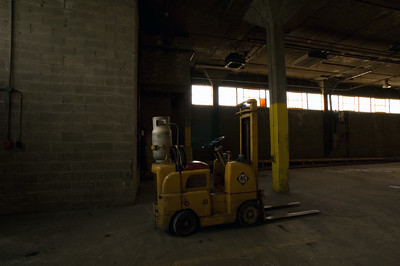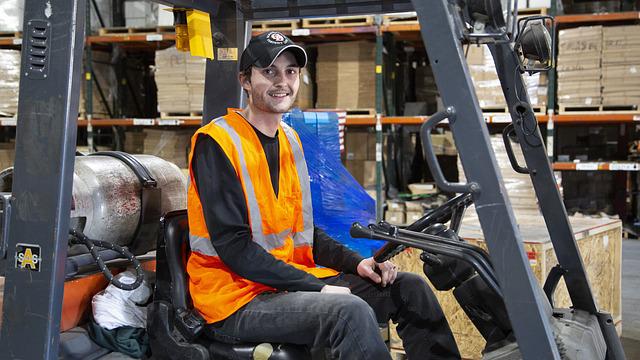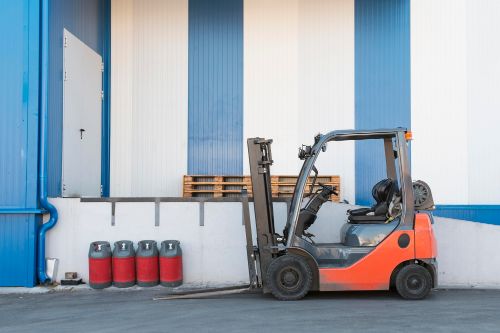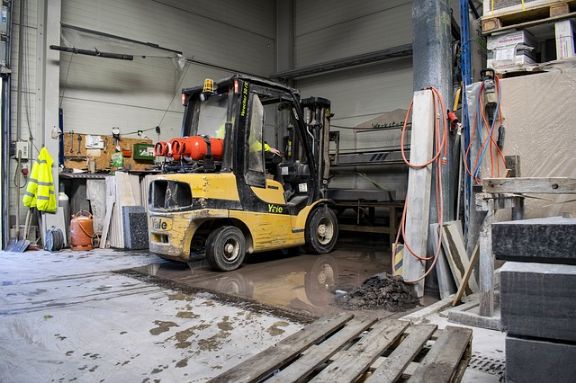
Forklifts that use propane as a fuel source typically have their tanks mounted in one of two ways: vertically or horizontally. There are advantages and disadvantages to each orientation, and the best way to mount a propane tank on a forklift depends on the specific model of the forklift and the application it will be used for.
Vertically-mounted propane tanks are the less common type. They are typically mounted on the back of the forklift, just behind the operator’s seat. This makes them easy to refill and helps to keep the weight of the tank evenly distributed. However, vertical tanks can be more vulnerable to damage in a collision, they can easily be knocked over and they can also be more difficult to operate when the forklift is carrying a load.
Horizontally-mounted propane tanks are more common, and they offer some advantages over vertical tanks. They are typically mounted on the back of the forklift, just like in the vertical tank, it is located at the back of the operator. Unlike, the vertical tank, it is not vulnerable to collision since the truck is somewhat “hidden” at the back of the operator. Vertical orientation is popular among modern types and models of forklifts.
Read related article: Replacing Service Valves on Forklift Propane Tanks: Short Guide

Common Mistakes
| Common Mistakes | Impacts |
|---|---|
| Putting a Vertical Tank Sideways and Vice Versa |
– Safety Risk: Can cause leaks leading to fires or explosions. – Bad Fuel Flow: Forklift might not receive propane correctly, causing performance issues. |
| Not Making Connections Tight |
– Gas Leaks: Loose connections can release propane, which is wasteful and dangerous. – Poor Forklift Performance: Can stall or reduce power due to bad fuel flow. |
| Not Paying Attention to Valves and Gauges |
– Safety Issues: Hard to turn off gas or check for problems if valves aren’t accessible. – Wasted Propane: Overfilling or running out without knowledge. |
Universal Forklift Propane Tank
As the name implies, the universal tank can be positioned either vertically or horizontally, and the forklift will run just fine. If you’re considering purchasing one of these tanks for your truck, here’s what you need to do:
- Consult the operator’s manual – there could be safety precautions or step-by-step in doing so in the manual. Or the use of a universal tank might not be recommended at all for the model of forklift you have.
- Get a professional recommendation from a qualified technician – if the forklift is relatively old, chances are you no longer have its operator manual. In this situation, getting a recommendation from a technician if a universal tank will suit your truck.
- Get advice from the forklift’s manufacturer – if you aren’t really sure, the best thing to do is to get advice from the manufacturer itself. The manufacturer can definitely provide the best advice if the universal tank can be oriented for the model of the forklift you have.
Let me give this advice, the universal tank can have a different regulator and can’t be used interchangeably. One type of regulator can show an Empty, ¼, ½, ¾ Full reading which is used for horizontal tank orientation, while vertical orientation will have just an Empty or Full reading.
Here’s How to Do the Exchange on a Forklift
Installation Guidelines for Forklift Propane Tanks
1. Selecting the Right Location on the Forklift
- Accessibility: Choose a location that is easily accessible for refilling and regular maintenance checks.
- Protection: The tank should be placed in a location where it is protected from potential collisions or impact, especially during normal operations.
- Compatibility: Ensure the chosen location is compatible with the propane system’s design, whether the tank is meant to be horizontally or vertically oriented.
- Ventilation: Propane tanks should be positioned in well-ventilated areas to prevent the build-up of gas should there be any minor leaks.
2. Attaching Brackets and Mounting the Tank Securely
- Selecting the Right Bracket: Ensure the bracket used is designed for the specific size and type of propane tank being installed. Using an ill-fitting bracket could lead to tank instability.
- Positioning the Bracket: Mount the bracket so that it provides stable support to the tank, considering the forklift’s movement and vibration during operation.
- Secure Fastening: Use the appropriate bolts or fasteners to attach the bracket, ensuring it is tightened securely to prevent any movement.
- Tank Placement: Once the bracket is in place, position the propane tank within it and secure it using the provided straps or clamps, ensuring it’s snug but not overtightened.
3. Connecting Hoses and Ensuring No Leaks
- Hose Inspection: Before attaching, check hoses for any signs of wear, damage, or aging. Replace any questionable hoses before installation.
- Proper Connection: Ensure the hose is connected to the appropriate valve or nozzle on the propane tank. Follow manufacturer guidelines for attachment.
- Tightening Connections: Securely tighten connections using the appropriate tools, being cautious not to overtighten or cross-thread, which can damage the fittings.
- Leak Test: After connecting, apply a soapy water solution to the connection points. Turn on the propane slightly. Bubbles forming indicate a leak, which needs immediate rectification.
4. Safety Checks Post-Installation
- Proper Orientation: Double-check that the tank is in its intended orientation (vertical or horizontal) and that no components are under undue stress.
- Ventilation: Ensure that there’s adequate ventilation around the propane tank, particularly if it’s in an enclosed space.
- Clear Path: Verify that the installed tank doesn’t obstruct the operator’s view or impede the normal operation of the forklift in any way.
- Emergency Protocols: Make sure that emergency shut-off systems are functional and that operators are trained in how to use them.
- Documentation: Keep a record of the installation date, any components used or replaced, and the date for the next scheduled inspection.
By following these installation guidelines, you’ll ensure that the propane tank on your forklift is not only efficiently installed but also safe for use. Regular maintenance and checks post-installation are crucial for the long-term safe operation of propane-powered forklifts.
Read related article: Forklift Propane Tank Exchange (Cost 2023, Where to Fill These Cylinders)
Why It’s Important to Put Propane Tanks the Right Way
Keeping People Safe
Putting propane tanks the right way on forklifts helps keep everyone safe.
- Avoiding Leaks: If a tank isn’t put right, it might leak. Leaks can cause fires.
- Keeping Pressure Safe: Tanks have special parts to release pressure. If the tank is not put correctly, these parts might not work, and the tank could become too pressurized.
- Avoiding Spills: If a tank is the wrong way, propane can spill when filling it.
Keeping the Forklift Running Well
Propane tanks need to be put the right way to make sure the forklift works properly.
- Steady Fuel: The forklift needs a steady flow of propane. If the tank isn’t right, the forklift might not get enough fuel and could stop suddenly.
- Only Gas, No Liquid: The forklift runs on propane gas, not liquid. If liquid goes into the engine because the tank is wrong, the forklift might not start or could get damaged.
- Less Damage Over Time: When the tank is right, the forklift’s engine lasts longer and has fewer problems.
Using Propane Well and Saving Money
Putting the tank the right way helps use propane best and can save money.
- Saving Fuel: The right tank position helps use propane efficiently. This means you don’t waste fuel, and you save money.
- Fewer Repairs: When the tank is right, the forklift has fewer problems. This means less money spent on fixing it.
- Tanks Last Longer: Using tanks the right way makes them last longer, so you don’t have to replace them often.
To sum it up, putting propane tanks the right way on forklifts is very important. It keeps people safe, makes the forklift work well, and can save money.
Safety Precautions When Handling Propane Tanks
Forklift operators must be aware of the potential hazards associated with forklifts powered by propane. Propane is a highly combustible gas and can be explosive if not handled properly. Improperly oriented propane tanks can cause the gas to leak, which can lead to fires or explosions.
Operators should always consult the manufacturer’s instructions when troubleshooting propane tank issues. If the tank is not properly oriented, the first step is to identify the correct orientation for the tank. The next step is to determine why the tank was not oriented correctly in the first place. This can be due to a variety of factors, such as incorrect installation, damaged parts, or incorrect assembly. Once the cause of the problem has been identified, it is important to take steps to prevent it from happening again in the future.
Forklifts that use propane fuel have a tank that must be properly oriented in order for the forklift to operate safely. The propane tank must be mounted on the forklift so that the valve is facing up. The tank must also be securely fastened to the forklift.
If the propane tank is not properly mounted and secured, it can become loose and fall off of the forklift, which can cause serious injuries or even death.
Always keep the propane tank away from any sources of heat or flame.
If you are not sure how to properly mount and secure a propane tank on a forklift, please consult the owner’s manual or contact a qualified technician.
Read related article: Forklift Propane MSDS: What Does the Document Contain?
How to Tell If Your forklift Propane Tank is Full
To check if your forklift propane tank is full, you will need to know the proper orientation of the tank. The tank should be vertical with the valve at the top. The valve should be turned to the left to open and to the right to close. To check the level of propane in the tank, open the valve and look at the gauge. The level of propane should be at least two-thirds full.
How to Determine the Age of a Forklift Propane Tank
There are a few ways to tell how old a propane tank is. One way is to look for a date stamp on the tank. This is usually located on the bottom or side of the tank. Another way to tell how old the tank is, is to look for an expiration date on the collar or data plate. If the tank is 12 years from the date of manufacture, it needs to be recertified.
Forklift Propane Tank Maintenance
Forklifts that use propane fuel must have their tanks regularly inspected and maintained to ensure safety and optimal performance. Propane is a highly combustible gas, so it is important to take proper precautions when handling and storing forklift propane tanks.
Before each use, check the tank for leaks, damage, or corrosion. If any is found, do not use the tank and contact a qualified technician for repair or replacement. Make sure the tank is properly secured to the forklift before starting it up.
When filling the tank, always use a certified propane dealer and follow the instructions on the filling station’s placard. Overfilling the tank can create a dangerous situation, so be sure to stop filling when the indicator shows that the tank is full.
After filling, check all connections for leaks and tighten them if necessary. Also, check the pressure gauge to make sure the tank is at the proper pressure. Propane tanks should be stored in a well-ventilated area away from any potential sources of ignition.
Read related article: Replacing Service Valves on Forklift Propane Tanks: Short Guide
Propane Tank Storage
There are a few key things to keep in mind when storing forklift propane tanks:
- The tank should be stored in a cool, dry place.
- The tank should be stored upright, with the valve pointing up.
- The tanks should be secured with straps or chains in vertical orientation so that they cannot fall over.
- The tank should be kept away from heat sources and flames.
- The tank should be inspected regularly for leaks.
By following these simple guidelines, you can ensure that your forklift propane tank is stored safely and correctly. Read related rule.
To Give a Final Word
There are a few things to consider when it comes to the orientation of your forklift’s propane tank. The first is the weight of the tank. A full tank can weigh up to 60 pounds, so you’ll want to make sure it’s properly secured. The second is the location of the fill valve. It’s important to know where this is so you can easily fill the tank when it’s time. Finally, you’ll want to consider the height of the tank. You don’t want it to be too high or too low, as this can impact the performance of your forklift.

Mike is an experienced propane technician with over 15 years of professional experience in the field. He has dedicated his career to helping customers with their propane needs, from installation to maintenance and repair. Together with Jeremy, he co-founded this website to provide useful information and guidance to customers seeking reliable propane services.



